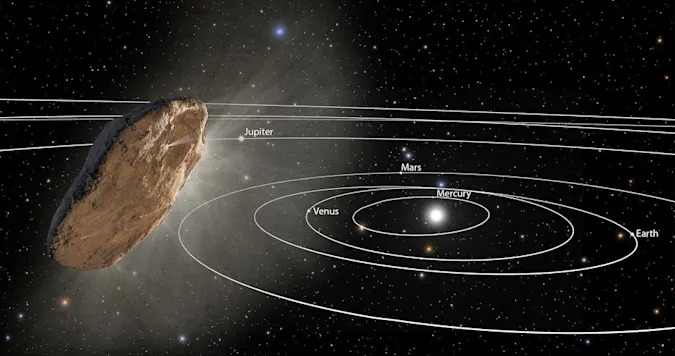
About Oumuamua, a mysterious object that flew from outer space in 2017 and passed by in an instant, a research team at Arizona State University argues that one of the peculiar properties is the action of nitrogen ice surrounding the object.
For the first time in the history of astronomical observation, this object, which has flown from outer space, was discovered at the Hawaii Observatory (Pan-STARRS1), and astronomical observatories around the world took note of it and conducted various observations. Because Omuamua passes in a hyperbolic orbit by the sun’s gravity, it is unlikely to appear in front of us again. It was only a very short period that astronomers were able to observe it.
The speed at which it flies could not be explained simply by gravity, so it was believed that the rocket effect commonly seen in comets worked. The rocket effect is a phenomenon in which the main component of ice evaporates and erupts when the comet approaches the sun, accelerating the comet. The similar phenomena-like behavior in Omuamua led to an early suggestion that there could be objects such as asteroids rather than ice.
However, in a pre-examination paper published by Harvard University astronomer Avi Loeb in October 2018, the subject’s behavior is a solar sale, and a probe that was deliberately displaced near the Earth by an alien civilization presented a surprising conclusion, drawing global attention. Received. Of course, many scientists disagree with this conclusion and rejected the theory, saying that the color, light reflectance, and size of objects are unnatural as artifacts.
The Arizona State University research team said that it was inevitable for people to be interested in alien civilization and to make people think of it by objects flying from outer space. He said he came to understand that Amuah’s rocket effect was nitrogen ice.
In another paper published in 2020, a study found that although Omuamua was originally a part of a large celestial body, it was pulled into the interstellar space due to its parental celestial energy. It is possible that the original celestial body had similar characteristics to Pluto. Pluto, like Neptune’s moon Triton, is covered with frozen nitrogen.
In this paper, it is revealed that Omuamua is also made of solidified nitrogen, which can be explained by a rocket effect propulsion that is different from water or ice. The research team calculated by applying various types of ice and various substances such as ammonia and hydrogen, including water, and found that the nitrogen ice matched the calculation. In addition, it is said that the reflectance of the nitrogen ice covering the surface of Pluto and the reflectance of Omuamua are close to the light reflectance.
The team says the Omuamua study has brought a new understanding of planetary systems that are different from the solar system. If the same generation of observatories, such as the large synoptic survey telescope being built in Chile, is implemented, it is expected to be able to discover more objects passing by in the solar system, and to statistic of what material it is made of or a block of nitrogen ice. It is also expected that we can learn a lot about whether our home planetary system has the same history as the solar system. Related information can be found here.


















Add comment